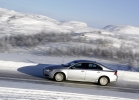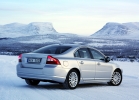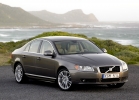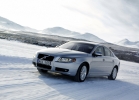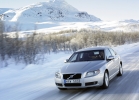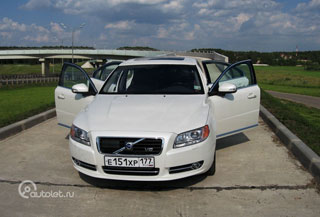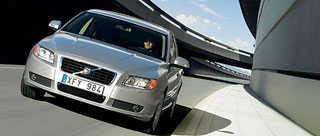Test drive Volvo S80 2006 - 2008 sedan
ice Age
 For almost half a century in the snow of Lapland, Volvo has been experiencing its cars. This winter, in the polar tests of the all -wheel drive Volvo S80 with a new T6 turbo engine, the pilot 5 wheels took part
For almost half a century in the snow of Lapland, Volvo has been experiencing its cars. This winter, in the polar tests of the all -wheel drive Volvo S80 with a new T6 turbo engine, the pilot 5 wheels took part Volvo S80 T6 AWD Price: from 1 696 000 rub. On sale: from November 2007
Thousands of years in the harsh climate of the northern regions of Scandinavia survived only the people of Sami, chasing herds of the northern deer between Swedish Lapland and Norwegian Fjords. And only in the XVII century, when ore deposits were found in Kirun, civilization came here. At the turn of the XIX-XX centuries, a railway was laid, connecting Kirun to the coast of the Baltic Sea. And in the 60s of the last century, Volvo chose these places for winter tests. Since then, cars have become the same integral addition to the Kirunsky landscape, which for many centuries have been herds of the northern deer.
In the midst of the winter test season, which lasts in Kirun from December to April, we also visited Scandinavia to test the Volvo S80 T6 AWD in extreme conditions of the ice age. The air temperature in those places often drops below 40C.
 The first test was waiting for our S80 already on the way from the airport to the hotel. It can be seen that during the day the narrow strip of the highway was carefully cleaned by graders, but under the raid of fresh snow that had fallen in the evening, an insidious ice formed in places. And many trucks that have to be overtaken, squeezing in snow dust into a narrow gap between the trailer and limiting hangers on the side of the road, do not allow to relax. In addition, our plane lingered slightly. And now, in order not to get out of the schedule and get to the hotel in time, you have to put pressure on the whole piece of iron. The speedometer arrow should not fall below 140 km/h. On any other representative of the representative class, night racing on an icy polar highway would hardly seem like a light walk. But not on the S80! It is felt that here in the snowy expanses of Lapland, Volvo feels like a fish in water.
The first test was waiting for our S80 already on the way from the airport to the hotel. It can be seen that during the day the narrow strip of the highway was carefully cleaned by graders, but under the raid of fresh snow that had fallen in the evening, an insidious ice formed in places. And many trucks that have to be overtaken, squeezing in snow dust into a narrow gap between the trailer and limiting hangers on the side of the road, do not allow to relax. In addition, our plane lingered slightly. And now, in order not to get out of the schedule and get to the hotel in time, you have to put pressure on the whole piece of iron. The speedometer arrow should not fall below 140 km/h. On any other representative of the representative class, night racing on an icy polar highway would hardly seem like a light walk. But not on the S80! It is felt that here in the snowy expanses of Lapland, Volvo feels like a fish in water. On the icy highway, the S80 is on the rails. The self-building active chassis with Four-C technology provides the driver with one of the three suspension settings: Comfort, Sport and Advanced with a sequential decrease in shock absorbers (at speeds of up to 15 km/h, the acuteness of the reaction to the steering system commands also automatically changes). For a long crossing to the Norwegian border, we choose comfort. We will test two other modes a little later on the ice highway.
 AWD all -wheel drive distributes the torque between the front and rear bridges using the controlled electronics of the hydraulic coupling. Instant Tractiontm technology allows you to redistribute the traction with lightning speed on slippery coating. And the system of dynamic stabilization and traction control (DSTC), coupled with Four-C, help to stabilize the behavior of the car on a snowy highway as much as possible, minimizing the probability of skidding when it enters the ice. True, the commands of the steering system S80 responds quite strainedly and with the laziness inherent in the representatives of the representative class. But on such a coating, this is even not bad: at high speed there is too sharp reaction of the car can play a cruel joke with the driver. Especially when you consider that under the hood S80 is a 285 -horsepower 3 -lifted turbo engine. It was created on the basis of the atmospheric engine Volvo 3.2 and is distinguished by enviable dynamics. The maximum torque of 400 nm is already reached by 1,500 min-1 and, thanks to the Twin-Scroll two-tract turbine, is maintained at this level up to 4800 min-1.
AWD all -wheel drive distributes the torque between the front and rear bridges using the controlled electronics of the hydraulic coupling. Instant Tractiontm technology allows you to redistribute the traction with lightning speed on slippery coating. And the system of dynamic stabilization and traction control (DSTC), coupled with Four-C, help to stabilize the behavior of the car on a snowy highway as much as possible, minimizing the probability of skidding when it enters the ice. True, the commands of the steering system S80 responds quite strainedly and with the laziness inherent in the representatives of the representative class. But on such a coating, this is even not bad: at high speed there is too sharp reaction of the car can play a cruel joke with the driver. Especially when you consider that under the hood S80 is a 285 -horsepower 3 -lifted turbo engine. It was created on the basis of the atmospheric engine Volvo 3.2 and is distinguished by enviable dynamics. The maximum torque of 400 nm is already reached by 1,500 min-1 and, thanks to the Twin-Scroll two-tract turbine, is maintained at this level up to 4800 min-1. Following the road test, it is time to evaluate the all -wheel drive system and the effectiveness of DSTC on ice, the benefit of the numerous Lapland lakes give such an opportunity. Turn on the Advanced mode, deactivate DSTC and go! The first thing that attracts attention is the perfect selection of rubber. The characteristics of Nokian Hakkapeliitta 5 provide very accurate and sharp reactions of steering, and bearish
 claw clings perfectly to the ice, holding the spike perpendicular to the surface as long as possible. The disconnected stabilization system does not particularly announce, allowing you to go through high -speed turns in a long controlled drift, but still at some points it is included in the control process. At first, this is slightly annoying, but there are enough pairs of circles along the ring ice track to adapt to the character of DSTC, and electronics interventions cease to seem unexpected. Having rolled into the track, you begin to get true pleasure from managing the S80. But it is worth putting DSTC in the ON mode, as everything turns upside down. The system, which on the road, of course, is one of the main trousers of the S80, on the ice simply fetters the driver hand and foot, not allowing the gas in corners until completely stabilization (and on ice it is almost equivalent to a stop) of the car. As a result, the first attempt to pass a long arc at the same speed as in the previous circle, ends with a departure from the trajectory.
claw clings perfectly to the ice, holding the spike perpendicular to the surface as long as possible. The disconnected stabilization system does not particularly announce, allowing you to go through high -speed turns in a long controlled drift, but still at some points it is included in the control process. At first, this is slightly annoying, but there are enough pairs of circles along the ring ice track to adapt to the character of DSTC, and electronics interventions cease to seem unexpected. Having rolled into the track, you begin to get true pleasure from managing the S80. But it is worth putting DSTC in the ON mode, as everything turns upside down. The system, which on the road, of course, is one of the main trousers of the S80, on the ice simply fetters the driver hand and foot, not allowing the gas in corners until completely stabilization (and on ice it is almost equivalent to a stop) of the car. As a result, the first attempt to pass a long arc at the same speed as in the previous circle, ends with a departure from the trajectory. DSTC does not accept the controlled drift! But it is more likely to be brought to the Volvo asset. S80 owners are unlikely
 it occurred to put this car to the ice rally. In road conditions, AWD all -wheel drive and stabilization system make the Volvo S80 one of the most stable and safe cars of their class.
it occurred to put this car to the ice rally. In road conditions, AWD all -wheel drive and stabilization system make the Volvo S80 one of the most stable and safe cars of their class. Swedish hardening
At the beginning of the second half of the last century, Volvo became the first automaker to decide to start the planned tests of its cars in harsh Arctic latitudes. Today, the temperature range in which the testing of pre -production and serial Volvo models is carried out is 100 s (from 40C in Kirun to +60C in the Arizona desert). For tests in conditions of the Lapland, the body of Lapland, the body of the cold, built its own landfill near Kiruna. But if the winter in the Arctic is issued too soft, the company's engineers can artificially complicate the lives of their cars. The landfill has special freezers in which artificial hardening of the Scandinavian horses. After a night in the freezer at a temperature of 30C, the car should be ready to start a cold engine and pass the detailed test of all systems. Winter tests not only allow you to work on the reliability of cars, but also to improve their design features. In particular, thanks to this testing program on Volvo, an automatic heating mode of the rear window and many other little things that facilitate the winter operation of cars have appeared.
Driving
Three settings of the active chassis allow to adapt the car to road conditions and the driver control style.
Salon
A constructive modern design, but the quality of the finish is somewhat inferior to German competitors.
Comfort
The convenience of the chairs cannot be found, but the sound insulation could be better.
Safety
The structure of the latest generation S80 provides controlled deformation in the event of a collision and is characterized by increased twisting stiffness.
Price
Cheaper than the main competitors.
Advantages and disadvantages
+ Adjustable suspension, a large range of engine operation with a maximum torque.
- The rear passengers are not too spacious, noise insulation does not go to the level of business class.
Specifications
Mark and model - Volvo S80 T6 AWD
Dimensions - 4851x1861x1493 mm
Engine - gasoline with turbocharged, 2953 cm3, 285 hp/5600 min -1
Transmission - automatic, 6 -speed
Dynamics - 250 km/h; 6.9 C to 100 km/h
Competitors-Audi A6, BMW 5-Series, Mercedes-Benz E-Class
Our opinion
The all -wheel drive S80 with a new powerful turbo engine is almost the perfect representative of the representative class for operation in Russian winter. A high level of security, traditional for Volvo, together with a relatively low price, significantly expand the circle of potential buyers of the S80.
Vladimir Makkaveev

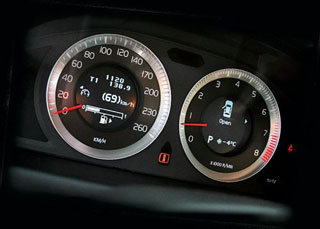
Source: Magazine 5 wheel [March 2008]

